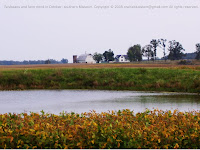Horse power requires fuel.
A century ago, thousands of tons of prairie hay were sold out of wild meadows each year. Railroads carried the hay to distant markets.
Hay was an important income source for homesteaders who were trying to get ahead. A 1908 New York Times article (pdf) states that hay was the second most important cash crop of Nebraska.
The 1919 Encyclopedia Americana reported that Nebraska was the biggest producer of prairie hay in the nation (2,544,000 tons in 1917). It also notes that the largest hay-shipping station in the world was located at Newport, Nebraska.
The following short description of the best of Nebraska's fine hay prairies was written in the late 1930, after the hay-shipping market had begun to decline:
West of O'Neill, the highway [Highway 20] passes through the great hay-producing country, which extends as far as Valentine in an almost unbroken stretch of prairie, dotted in the fall with large haystacks.
Source: Nebraska, a Guide to the Cornhusker State (page 310), by The Federal Writers Project, Nebraska. Published in 1939 by US History Publishers.
And where did the railroads carry all this hay? Some of it went to the horses of the U.S. Army, but much of it went to cities, to feed the millions of horses that labored in the streets.
If one assumes an urban horse population of approximately 3 million in 1900, then 7,200,000 tons of hay and 4,200,000 tons of oats were consumed by city horses per year. To grow this amount of fodder may have required as many as 15,000,000 acres.
Source: The Making of Urban America (page 120) by Raymond Mohl. Published by Rowman & Littlefield in 1997.
The production of hay for the urban horses was an important part of the economy. In the early 1930s, the Horse Association of America (HAA) issued several statements that blamed the depression in the agricultural sector on the automobile. They claimed that the ag depression would never have happened if automobiles, etc., had not largely replaced horses in city streets, and they provided a set of figures to prove it.
The authors of The Horse in the City think that the HAA may have underestimated the amount of hay needed, had horses and mules still been powering all city vehicles in 1930. However,
[t]here can be little dispute that the amount of land needed to feed urban horses and mules was vast. In short, horses had to eat in order to produce energy, and the food they consumed absorbed the output of large amounts of agricultural land, required massive capital and labor inputs for production and transportation, and necessitated an extensive regional and urban distribution system.
Source: The Horse in the City (p. 129) by Clay McShane and Joel Arthur Tarr. Published by JHU Press in 2007
The importance of hay in the economy helps to explain why the New York Times archives from the era of horses contain many reports of prairie fires. An example is the article, A Disastrous Prairie Fire (pdf), which burned a portion of the hay crop in the Newport, Nebraska area.
Besides the interest that the public always has in disasters, such fires were matters of concern to business people. Just as we watch the price of gasoline today, people watched the price of hay then.


















